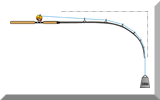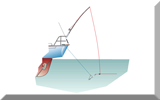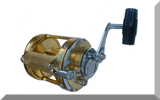- Home
- Artificial Lures
- Leadheads
How to Rig Saltwater Leadheads Correctly
Saltwater Leadheads, or saltwater leadhead jigs as they're also known, are soft plastic swimbaits. They are supplied as either a one-piece 'ready to fish' lure with the leadhead encapsulated within, or in two parts - a metal jighead from which emerges an upward facing hook, and a soft plastic tail through which the hook is inserted.
Whilst the jighead part of the lure is very durable, the tails aren't.
After a few fish, they'll get beaten up and lose their effectiveness.
The tails are sold separately, and are produced in various sizes and colour patterns, each designed to imitate one of the many types of baitfish that your intended prey will be looking for.
So it's worth having a reasonable selection of tails, not just as spares, but also as alternative shapes and sizes so you can ring the changes and find the one that gets results.
Rigging Leadheads
The soft plastic tails usually take the form - with varying degrees of realism - of marine worms, sandeels or shads. The jighead should be chosen to suit the type of tail that you want to attach it to. It's the shad verion that's shown here...
First, you should check that the back of the 'head' and the front end of the soft plastic shad will fit neatly together - if it doesn't, you'll need to trim it with a sharp knife as shown below.
 The Lead Head
The Lead HeadHaving trimmed off the head, place the jig hook alongside the shad and mark the place on the centreline at which the hook-point should emerge.
 The Soft-Plastic Shad
The Soft-Plastic ShadThen insert the hook in the forward face of the shad, and in a single movement thread the hook through the lure and out at the mark.
Perfect!
 Ready to Catch!
Ready to Catch!Artwork by Andrew Simpson
Doesn't Look Right? Start Again!
But if the lure is either stretched or bunched on the hook you've not got it right - in which case you should carefully remove the hook and start again.
Rigged thus, leadhead lures can be trolled slowly astern, jigged vertically from a drifting boat, cast from the shore - or best of all in my experience - cast astern and then twitched slowly along the seabed using a sink-and-draw technique from a drifting boat.
Note that the hook emerging from the top of the lure goes a long way towards preventing the collection of seaweed and seabed debris.
If you're looking to buy leadheads, the Offshore Angler range of jigheads would be a good place to start.
Rigging Leadhead Jigs Without the Leadhead
Without the leadhead, the plain shad shown above would be rigged with special cranked hook and used on a short snood where you may have otherwise used a plastic muppet.
 Soft Plastic Shad and Special Cranked Hook
Soft Plastic Shad and Special Cranked HookRead more about rigging unweighted leadheads (shads) and jelly worms...
Recent Articles
-
Sea Fishing Rods and Reels Must Be Compatible for a Balanced Outfit
Mar 08, 21 08:30 AM
A quality reel fitted to a quality rod doesn't necessarily make it a quality outfit. Your fishing rods and reels have to be properly matched if you're to get the best out of them, and here’s how -
Essential Lure Fishing Tips That All Saltwater Anglers Should Know
Mar 08, 21 04:51 AM
Which single lure fishing tip applies to trolling, jigging, baitcasting, spinning, fly fishing and any other branch of lure fishing? Well, it is the one at the top of this list -
Vital Jig Fishing Tips That You Really Cannot Afford To Miss!
Mar 07, 21 10:20 AM
Essential jig fishing tips to help you select the right lure for successful jig fishing, together with the techniques required to get the most out of your jig fishing outfit


















New! Comments
Have your say about what you've just read! Leave me a comment in the box below.